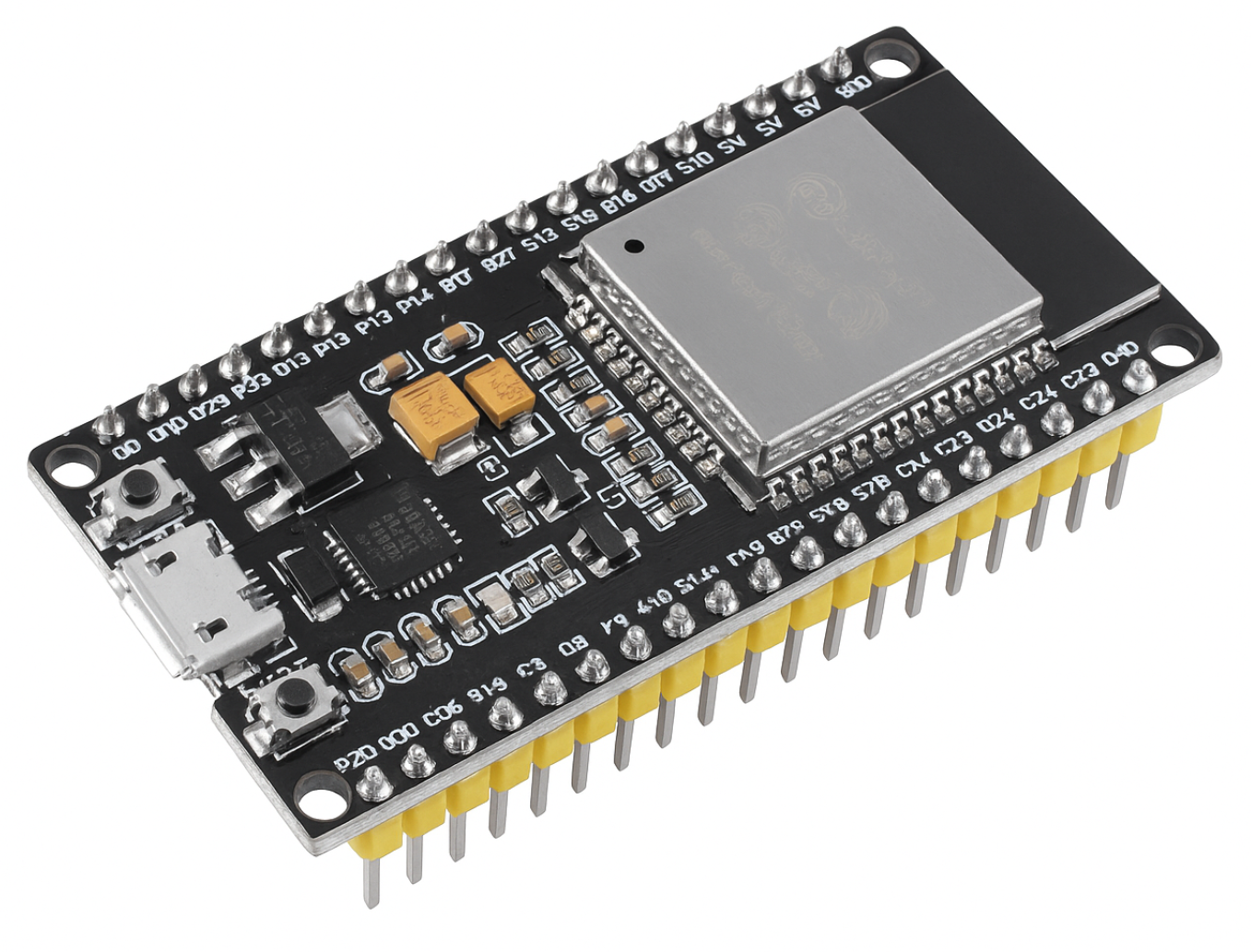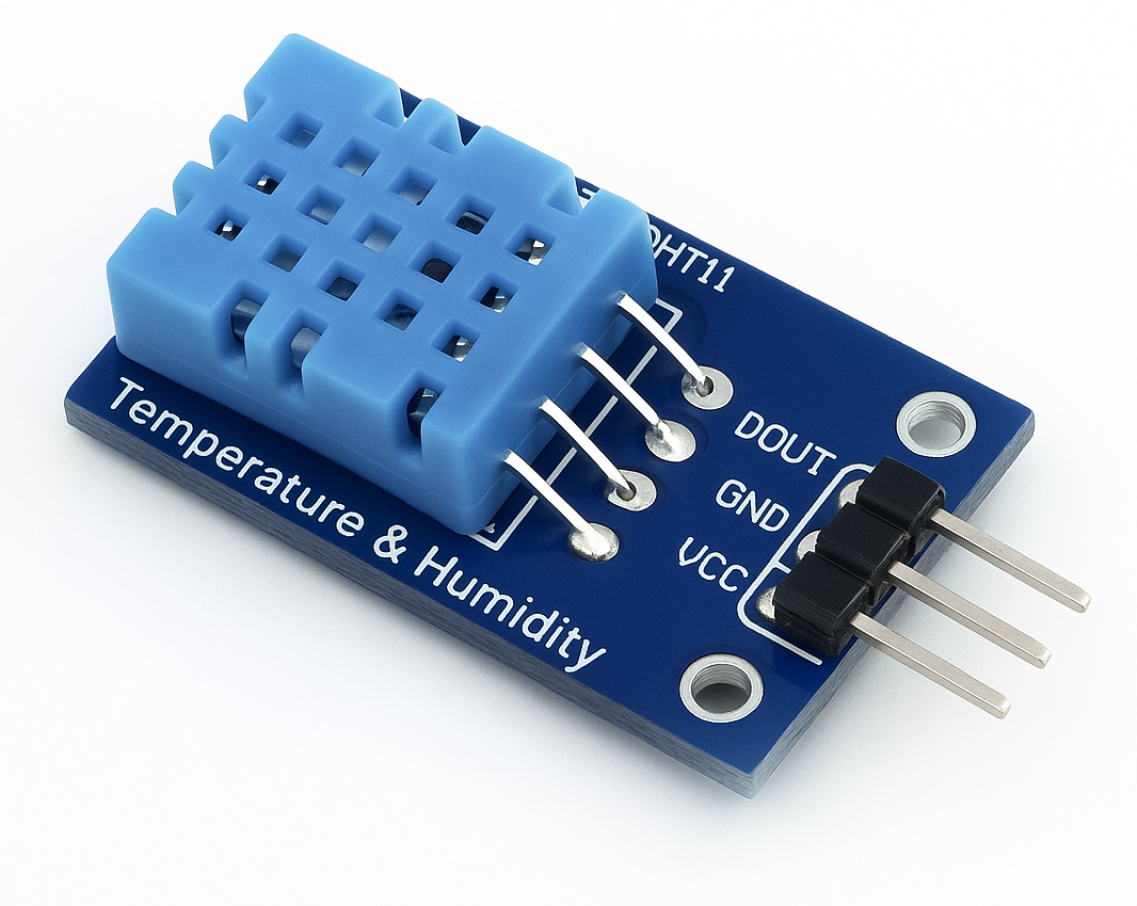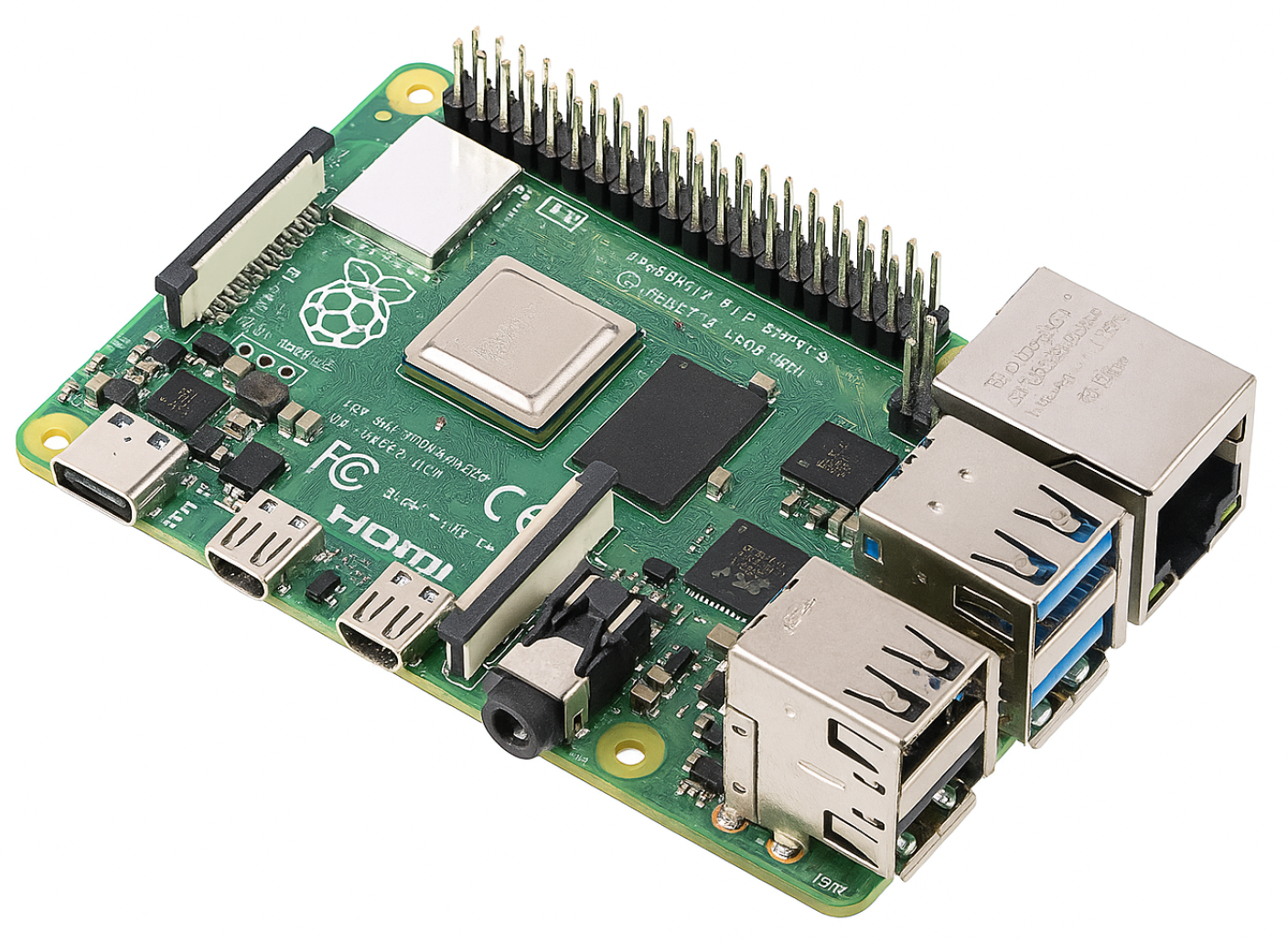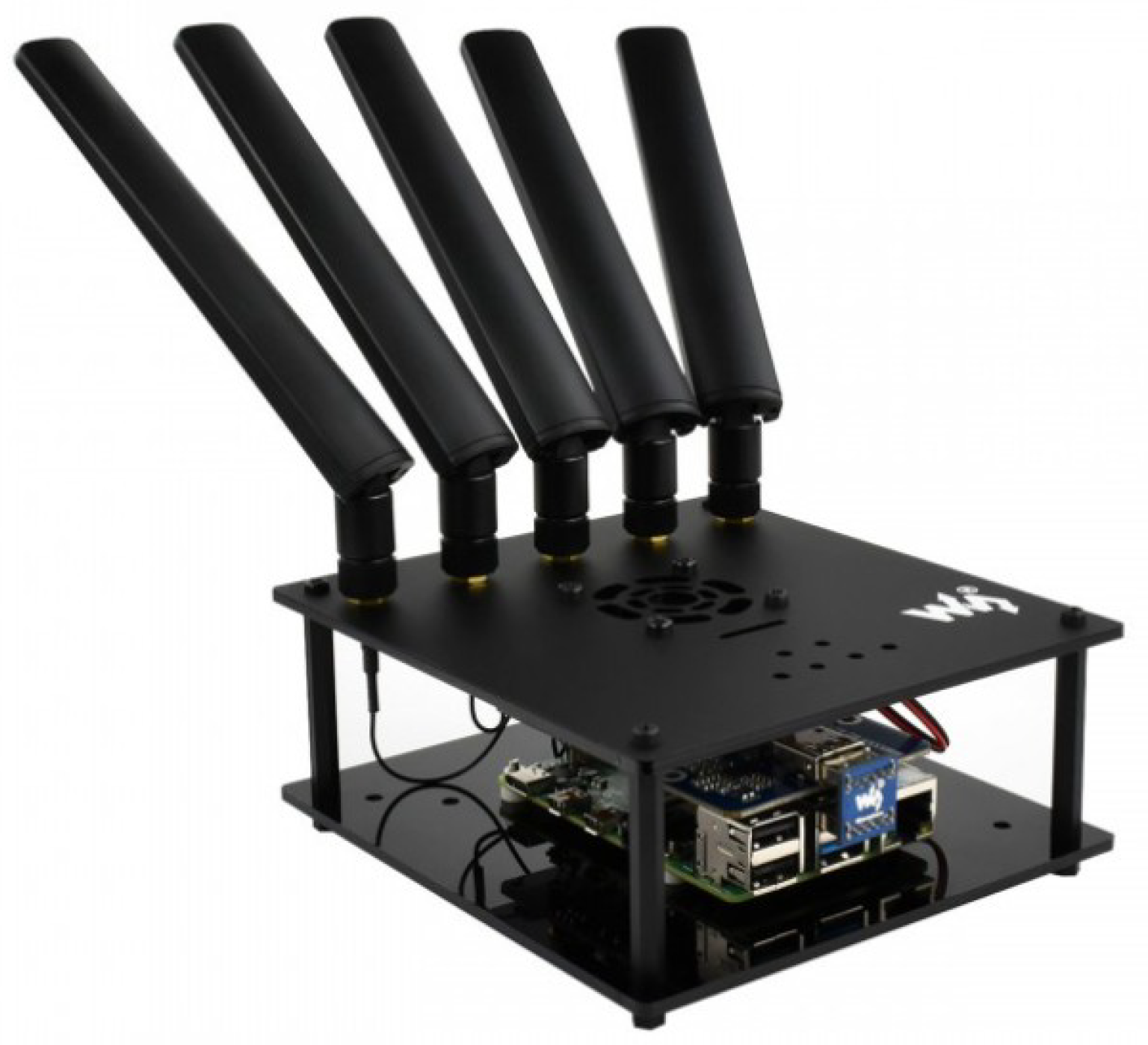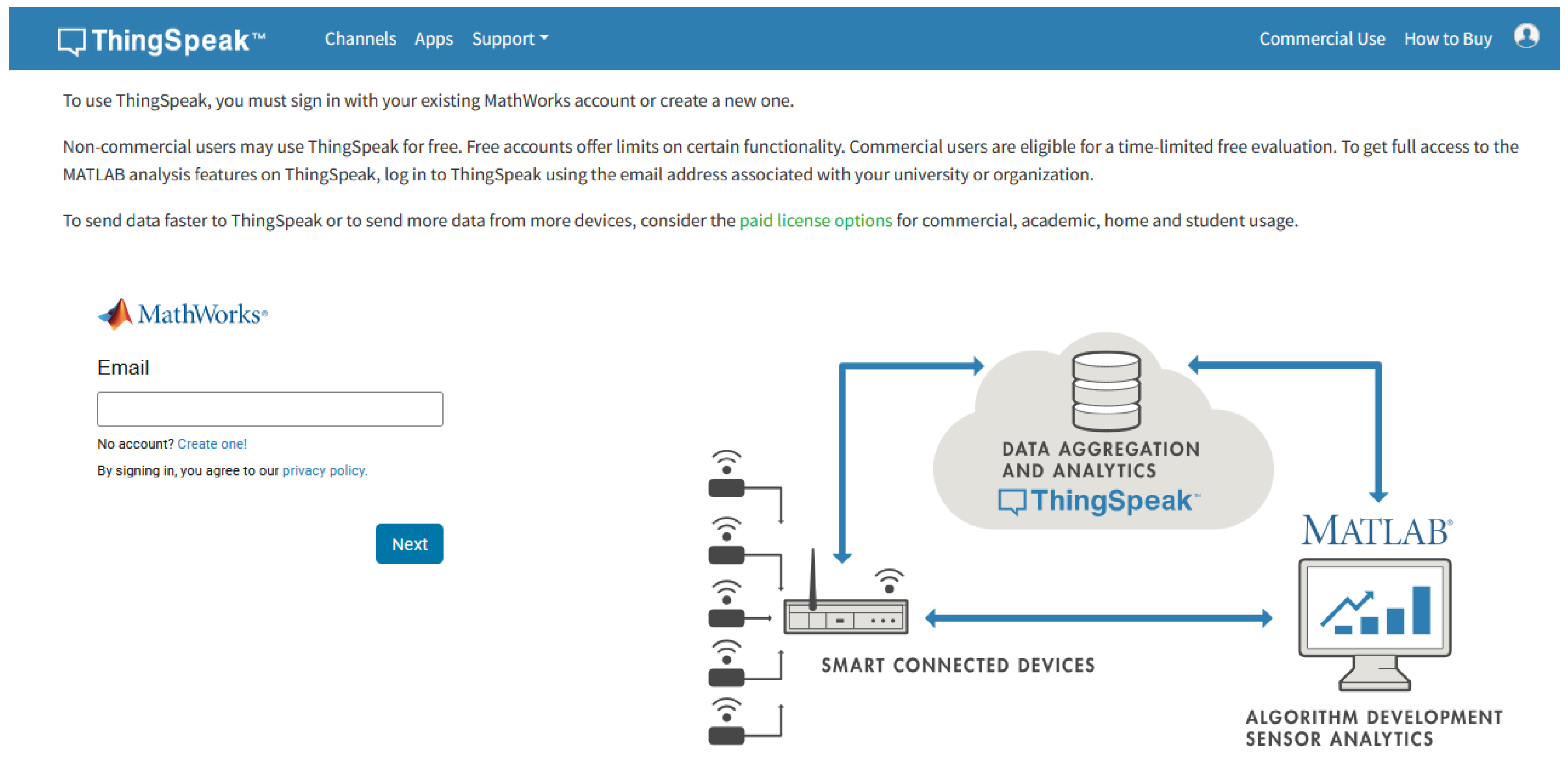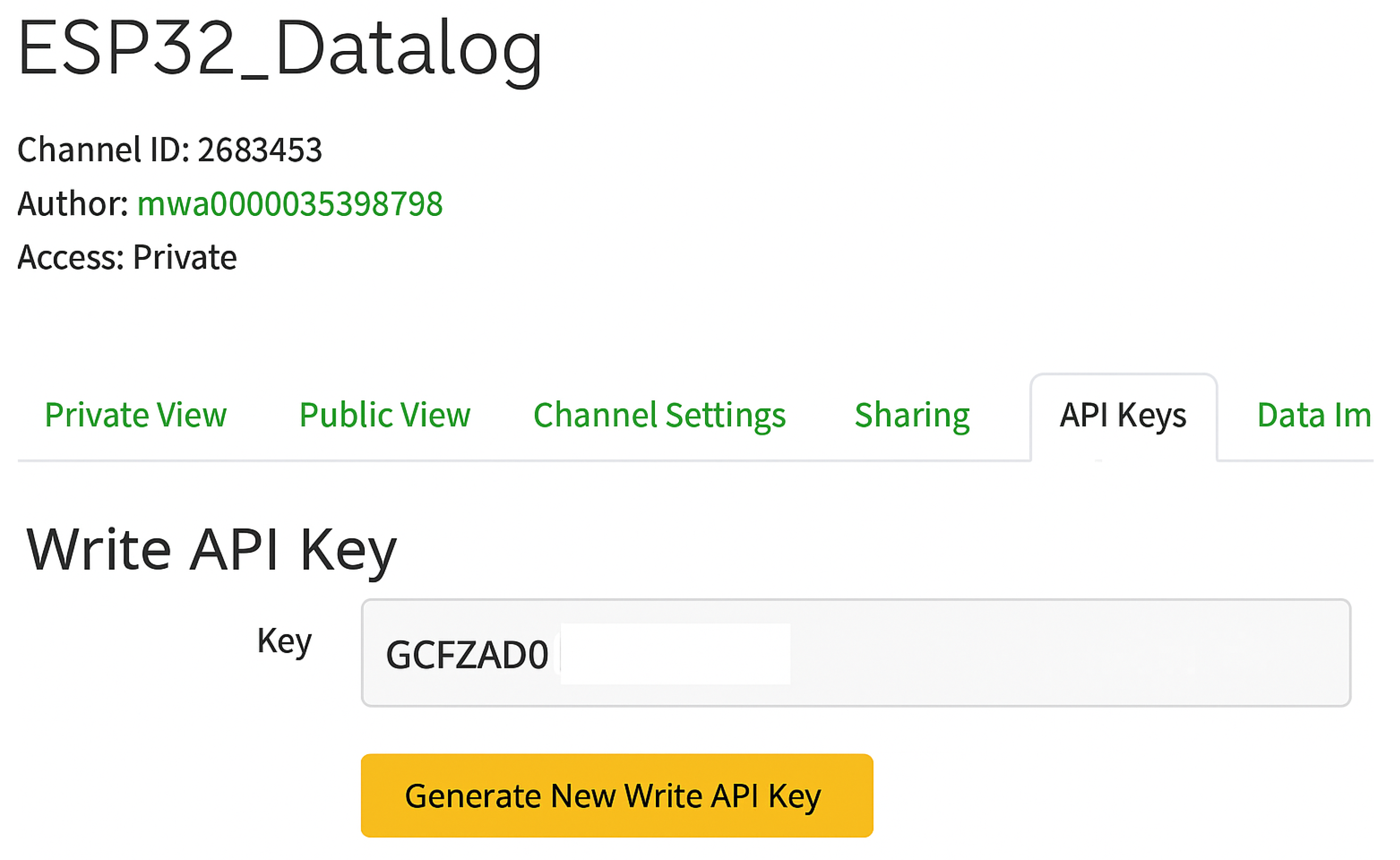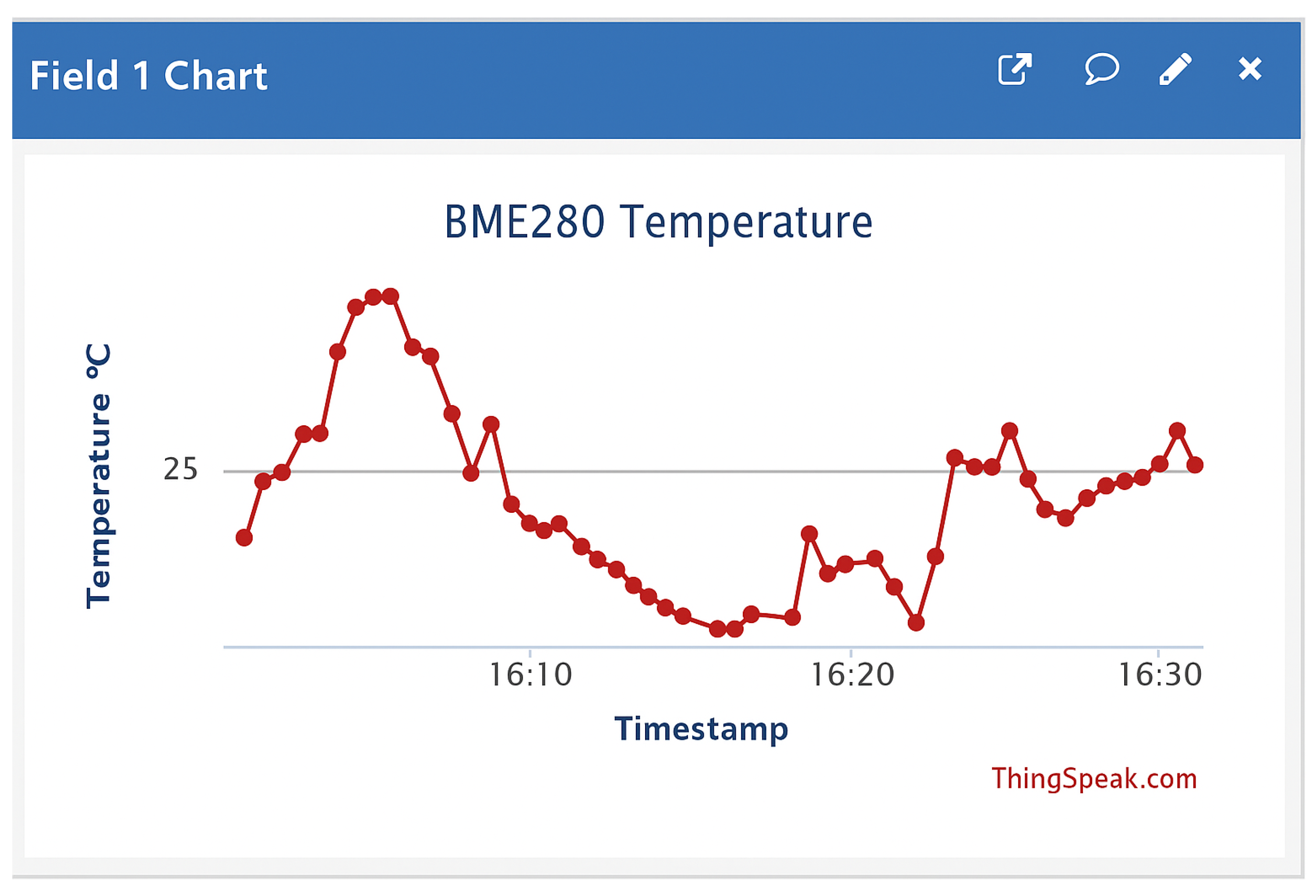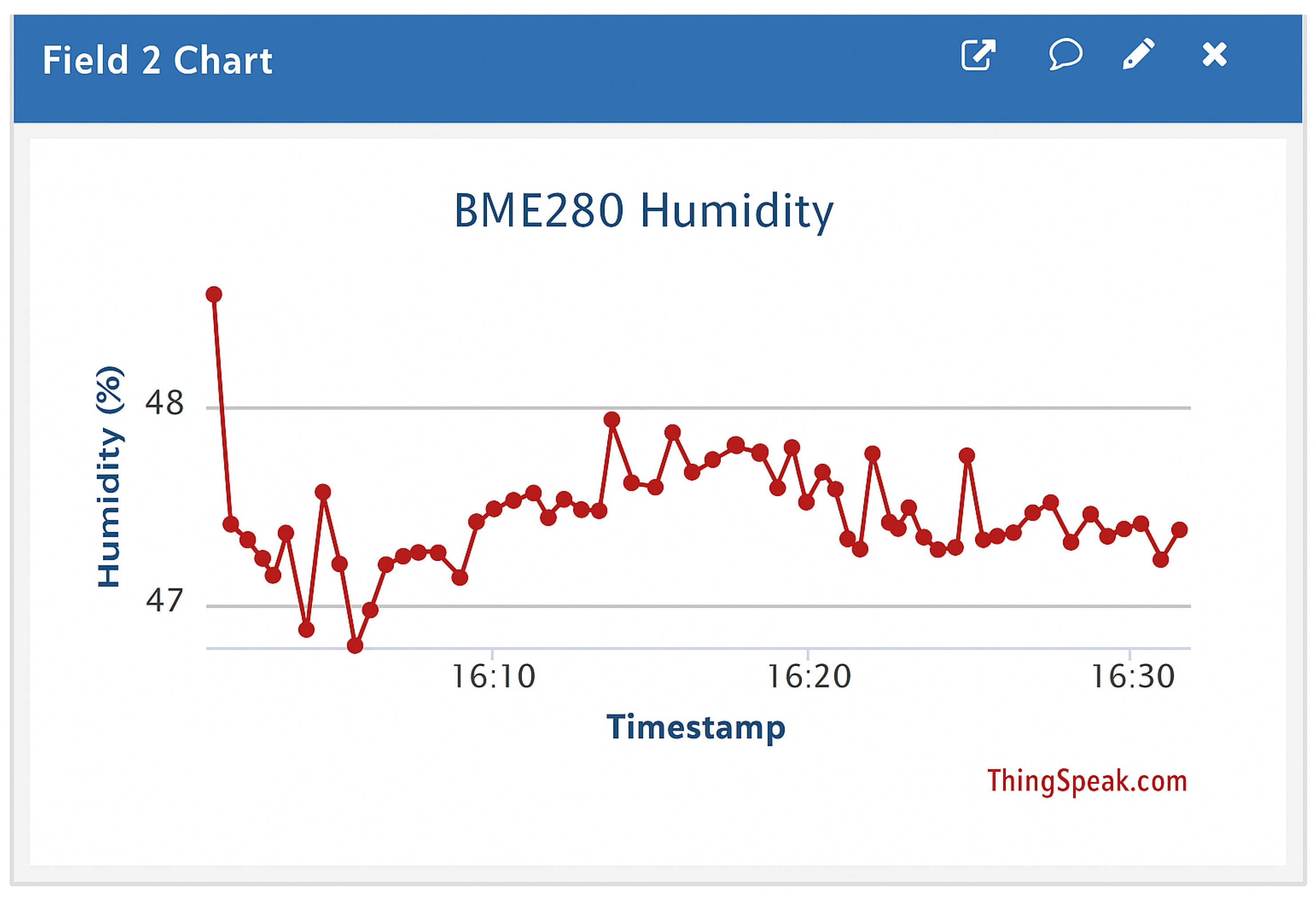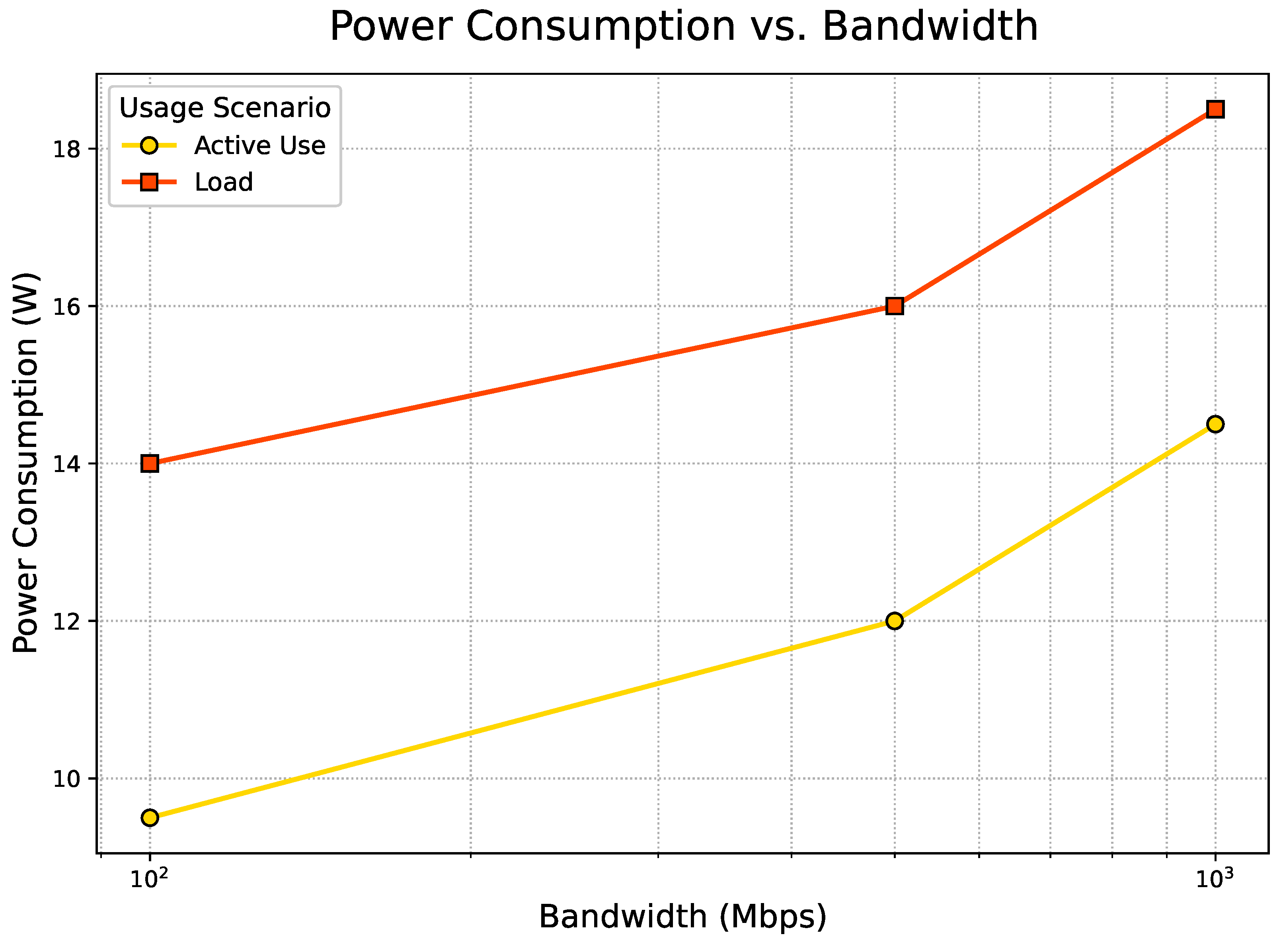1. Introduction
Internet of Things (IoT) networks have been transforming the cyber-physical landscape during the past few years as they enable the interconnection of physical devices, such as sensors, machines, appliances, vehicles, etc., to the internet, allowing these objects to collect, exchange, and act on data [
1]. The key features of IoT networks is that they allow a multitude of new features on physical devices, including (a) automation and intelligent decision making [
2], (b) real-time monitoring and control [
3], (c) efficiency and cost reduction [
2], (d) smart cities and infrastructure [
4], (e) healthcare transformation [
5], (f) industrial IoT [
5], (g) environmental monitoring and sustainability [
4], and (h) security and safety enhancements [
5,
6,
7].
The traditional architecture for interconnecting IoT systems usually utilizes the existing network infrastructure (e.g., Wi-Fi or Ethernet), or alternatively relies on a dedicated wireless network [
8], such as ZigBee [
9], Bluetooth Low Energy (BLE) [
10], z-Wave [
11], LoRaWAN [
12,
13], and many others. These technologies have the advantage of relying on unlicensed radio frequencies, and therefore can be used without a subscription for each device. Additionally, the dedicated wireless networks have been designed specifically for IoT applications, and have benefits in terms of energy efficiency compared with Wi-Fi. On the other hand, they require a gateway to facilitate the communication between the wireless network and the rest of the infrastructure, thus having increased installation complexity compared with Wi-Fi devices.
At the same time, as the cost of cellular networks keeps decreasing, and the bandwidth keeps increasing, the 5G and beyond network seems an increasingly attractive alternative [
14,
15,
16]. The advantages of the 5G network include (a) high data rates and bandwidth [
17], which may be orders of magnitudes larger than some other technologies, (b) ultra-low latency [
18], which can be as low as 1 ms, (c) massive scalability [
17], allowing for the system to increase the number of sensors without costly infrastructure updates, (d) mobility support [
19], since the networks are inherently mobile, (e) network slicing and QoS [
20], allowing for multiple operators and/or applications to share the same infrastructure, (f) Integrated Edge Computing [
21,
22], allowing for computation very near to the source of the data streams, and g) enhanced security and reliability [
23].
This paper focuses on exploring the suitability of the 5G network for an environmental monitoring system, using off-the-shelf equipment and technologies. The implementation and deployment consists of an IoT sensor monitoring system that includes hardware parts such as ESP32 [
24] and Raspberry Pi [
25] using Bluetooth Low Energy (BLE) [
26] and wireless networks for real-time transformation of real-time data. All of the above is implemented by optimizing data processing at the edge, ensuring reliable cloud connectivity for scalability and efficiency, and reducing any network congestion.
The motivation for this research stems from the need to leverage 5G networking technology to enhance IoT sensor monitoring systems; thus, the implementation of a system that utilizes 5G to achieve real-time data collection and monitoring, overcoming limitations of traditional sensor network deployments, is investigated. By focusing on optimizing data processing at the edge, ensuring reliable cloud connectivity, and reducing network congestion, this research aims to provide a valuable contribution to the development of next-generation IoT-based wireless communication systems [
27,
28].
The research problem is the following: what is the energy efficiency and latency of an IoT system that relies on 5G networking instead of traditional architectures? In order to answer this question, we have designed and implemented a sensing architecture that consists of an ESP32 microcontroller, with a sensor, a Raspberry Pi, and a 5G module. This sensing node is connected to the ThingSpeak cloud platform in order to visualize the data in real time.
The results show that the power consumption of the ESP32 monitoring system and the sensors is very satisfactory; however, the introduction of the Raspberry Pi and the associated 5G module drastically increases the power consumption of the setup. Therefore, dedicated ESP32 5G modules are necessary to limit power consumption to a value that would allow practical autonomous operation.
The contributions of this paper are the following:
It leverages 5G technology to improve real-time data collection and in parallel monitoring within the IoT sensor systems.
It addresses the limitations of traditional sensor networking like bandwidth, latency, and networking congestion.
It emphasizes edge computing in order to optimize local data processing before transmission.
It ensures the reliability of cloud connectivity for scalable and efficient system performance.
It aims to advance the next-generation of IoT systems, contributing to the evolution of wireless communication technologies.
Some related papers have been identified from the literature. Specifically, [
29] investigates energy savings in hydraulic press systems, reducing electrical consumption by replacing traditional Direct-On-Line (DOL) starters with VSD-controlled motors. This is an IIoT system allowing efficient remote data collection and analysis and in parallel reducing audit time and cost. In addition, [
30] explores parallel deep reinforcement learning (DRL) methodology for 5G network resource allocation in order to achieve spectrum efficiency and latency. With the use of multiple DRL agents, there is an improvement in convergence speed and scalability. Paper [
31] proposes an enhancement of IoT devices security by prioritizing 18 critical security features, ending up with a security priorities list that helps the researchers to focus on the most impactful features for securing an IoT system. Finally, [
32] focuses on an Over-the-Air Computation with multiple shared wireless channels of an industrial environment. There are a large number of sensors continuously sending data-related information in order to monitor, power control, and detect any faults, leading to the improvement of data aggregation in industrial Internet of Things (IIoT) environments.
The paper is organized as follows:
Section 2 presents the system architecture that was experimentally studied in this paper,
Section 3 presents the methodology and results of each of the experiments carried out for this study,
Section 4 discusses the findings and suggests future work, and finally
Section 5 contains some concluding remarks.
2. System Architecture
The system under consideration is a system designed to automatically collect, transfer, and visualize data over a 5G network. The purpose of the measurements is to monitor the atmospheric conditions of a secluded area. It is implemented in the following layers: the measurement layer, the data collection layer, and the data storage and visualization layer (
Figure 1).
The solution for implementing our experiment was guided by three factors: cost efficiency, development flexibility, and modularity. ESP32 is a very powerful microcontroller with native BLE support and ultra-low power consumption, making it ideal for our experiment. On the other hand, Raspberry Pi is a Linux environment ideal for easy code development, debugging, integration, and updates with cloud services. All the above are factors that provide easy system maintenance and scalability, although these components are not ideal for power-critical environments, which is the novelty of our experiment.
The measurement and data collection layers are deployed to a remote location. This part of the whole system consists of two primary components: an ESP32 microcontroller with a connected sensor, and a Raspberry Pi acting as a Bluetooth Low Energy (BLE) server. These components communicate using Bluetooth Low Energy (BLE), which is a power-efficient wireless communication protocol widely used for IoT (Internet of Things) devices.
The measurement layer is the device acting on the field to conduct the measurements, organize the measured values, and transmit them. The main device of this layer is an ESP32 connected with the needed sensors (
Figure 2). It is a versatile microcontroller with built-in BLE capabilities, making it ideal for use in IoT applications where low-power wireless communication is essential. In the system, the ESP32 is connected to a sensor that gathers data (for example, temperature, humidity, or motion) (
Figure 3). The ESP32 is configured to act as a BLE client, which means that it initiates communication with the BLE server (Raspberry Pi) to send the sensor data.
Data collected from sensors during a specified interval are structured into a single string for transmission to the next processing layer. Each sensor reading is prefixed with a distinctive letter or phrase to indicate the type of measurement. For instance, if the system captures temperature and humidity values, the resulting string could be organized as T34H46, where T represents temperature and H represents humidity, followed by their respective values. The data collection layer is subsequently responsible for decoding this string format, ensuring accurate interpretation of the sensor readings.
The Raspberry Pi (
Figure 4) serves as a server in the data collection layer, decoding the data string after receiving it from the ESP32. As a BLE server, the Raspberry Pi broadcasts its location and awaits connections from BLE clients, like the ESP32. In this configuration, the ESP32 communicates with one or more Generic Attribute Profile (GATT) [
33] services hosted by the Raspberry Pi. The structure of the data being transferred is specified by these GATT services. After waiting for the ESP32 to establish a connection, the Raspberry Pi takes in incoming data. After connecting, the ESP32 can transmit sensor data as BLE characteristics, which can then be processed further for real-time applications, such as data storage, or stored locally on the Raspberry Pi.
Communication between the measurement layer and the data collection layer is facilitated via the BLE protocol. The BLE protocol used for communication is specifically designed for low-power, short-range applications. It is ideal for devices like the ESP32 that are often battery-powered and need to transmit small amounts of data intermittently. The BLE connection is initiated by the ESP32 (the client), which scans for the Raspberry Pi’s BLE advertisement (the server). Once connected, the ESP32 reads or writes BLE characteristics as defined by the GATT services on the Raspberry Pi.
BLE’s advantage is its energy efficiency. Devices remain in low-power modes most of the time and only wake up to transmit small bursts of data, such as sensor readings. This is crucial for IoT systems, where power consumption needs to be minimized.
The ThingSpeak platform, which provides cloud-based management of real-time sensor data sent from the Raspberry Pi over a 5G network, acts as the system’s data storage and visualization layer. The platform enables the system to safely store environmental data, including temperature and humidity, and display them in real time through dashboards that can be customized. ThingSpeak allows users to track trends and patterns over time by time-stamped each incoming sensor reading. This is particularly helpful for monitoring isolated or remote locations. By facilitating sophisticated data analysis and predictive modeling, its integration with MATLAB (
https://www.mathworks.com/products/thingspeak.html (accessed on 5 August 2025)) improves the platform even more and provides insights beyond simple monitoring. However, ThingSpeak does come with limitations, particularly in terms of data transfer and processing capabilities. The free version of ThingSpeak restricts the rate of data updates, with only one data point allowed every 15 s, and limits the total number of data points that can be stored. This could pose a challenge for systems that require high-frequency data transmission or real-time responsiveness in fast-changing environments. Additionally, the platform’s free tier limits the amount of data that can be processed simultaneously, which may require the use of paid subscriptions for larger-scale applications or more frequent data transfers. Due to these limitations, ThingSpeak is not ideal for immediate-response requirements or high-volume data collection, but it is still an excellent solution for low-to-moderate data throughput in a variety of IoT projects.
There are limitations on the data packet size that ThingSpeak can send to its cloud platform. Each packet constitutes an API call and can send up to eight fields of data with a maximum size of 255 bytes for each field. It comprises the data recorded by the sensor and its accompanying metadata or timestamps. This packet size is usually enough for small-scale IoT tasks that only manage small sensor readings such as temperature, humidity, or motion, but can get limiting when it comes to more complex or high-resolution data.
A 5G cellular network is utilized in this system to facilitate rapid and reliable transmission of sensor data from peripheral locations into the cloud. To achieve the above, a Waveshare SIM8200EA-M2 5G module is integrated on the Raspberry Pi to give it the capability to connect to the internet through the high-speed 5G cellular network. The Raspberry Pi interacts with the modem through a USB interface. This 5G module acts as a modem connecting the Raspberry Pi to the cellular network, giving the device constant wireless real-time data transfer ability.The 5G network’s low latency and high bandwidth make it ideal for all the needed IoT data transmission, in our case for constant remote monitoring of environmental conditions.
The 5G SIM8200EA-M2 module easily interfaces with the Raspberry Pi for seamless integration, and uploads sensor data from the ThingSpeak cloud via USB 3.0. It offers both 5G NSA (non-standalone) and SA (stand-alone) architecture support, allowing it to function over a wide range of network coverage. If a 5G network is unavailable, the module will switch to LTE or 3G, which maintains a constant connection. This feature is important for IoT systems that deploy remote environments with unpredictable network coverage issues (
Figure 5).
As network coverage, 5G technology is ideal for IoT applications that need reliable and high-speed internet access connectivity in order to send sensor information from hard-to-reach areas. The substantial bandwidth provided by the 5G network ensures that the 5G link will not be the bottleneck for the transmission of our system’s data. Specifically, in our system we transmit up to 255 bytes per packet, with each packet transmitted every 15 s. This makes the 5G-enabled Raspberry Pi configuration a versatile and dependable option for IoT applications that need sustained data transfer in remote locations.
2.1. Equipment Used and Specifications
The methodology behind designing the experiment is based on the following principles for the selection of the sensors: they should be low-cost, low-power, and widely supported sensors. The selection of the communication protocol is based on energy efficiency, and therefore BLE was selected and not ZigBee, which is best used on mesh networking rather than point-to-point communications. More specifically, the sensors were chosen for their simplicity, low power usage, and sufficient accuracy for basic environmental monitoring. The chosen communication protocol (BLE) was selected for its short-range and energy-efficient communication between the ESP32 and Raspberry Pi. The Raspberry Pi supports reliable cloud connectivity with the support of BLE and the 5G network, which offers high bandwidth with low latency, ideal for IoT systems. The data transmission of a 10 s timeframe using an encoded string of T34H46 (temperature and humidity) ensured real-time updates based on ThingSpeak limitations and in parallel we minimized the energy use. Power consumption was measured using a USB power meter and iperf3 based on realistic load scenarios with solar panel testing for feasibility for sustainability. The MQTT protocol was chosen as a future upgrade for better scalability and network flexibility.
Table 1 and
Table 2 demonstrate the essential hardware chosen for the gateway and sensing stack. For each item, they summarize key specifications, such as the processor type and speed, memory, I/O ports, wireless and wired connectivity, power requirements, and, where applicable, peak data-rate figures.
2.2. Communication Protocols
Protocols such as ZigBee and Bluetooth Low Energy (BLE) are used in IoT applications, with all of them serving as wireless communication protocols with specific differences in data bandwidth, power consumption, and accuracy [
34]. In terms of power saving, BLE is an improved optimized protocol for low-power consumption, making it ideal for devices that operate with batteries and need to send small numbers of data such as sensor readings. ZigBee, which is another energy-efficient protocol functioning as a mesh networking protocol, allowing multiple devices to be connected over long distances with moderate pacing but consumes more power over large periods of time compared with BLE. Regarding data transmission rates, BLE performs communication rates of up to 1 Mbps, ideal for most of IoT applications, and ZigBee has lower rates of up to 150 kbps but with excellent range and network scalability. In terms of fidelity, BLE is the one that provides value in short-range communications with low error rates especially in point-to-point communications, like ESP32 and Raspberry Pi.
Bluetooth Low Energy (BLE) is currently the best protocol for simple low-power point-to-point communications, like ESP32 and a Raspberry Pi, although it has limited scalability. ZigBee and Thread are both used for large-scale IoT security advanced-complex mesh connections. Wi-Fi Direct is a protocol that offers high data throughput like media sharing, making it a not-ideal protocol for us to use due to its power consumption requirements and less attractive for sensor-based IoT systems communications.
Comparing the most popular communication protocols that are used in IoT applications, we can say the following:
LoRaWAN is the most energy efficient for long-range protocol, low-frequency communication, ideal for remote environmental monitoring, and has a long battery life.
BLE is ideal for short-range communications with high-frequency, and has ultra-low power consumption requirements.
ZigBee provides a good balance between range and power, but with higher energy costs.
Table 3 summarizes the key differences between these protocols.
The power source of the ESP32 in IoT is batteries. This greatly benefits from BLE’s low-energy power consumption, which enables longer operational periods without the frequent need for recharge. In addition to this, the 1 Mbps data rate for BLE is more than enough for compact data strings from the sensors (e.g., temperature, humidity readings), while the point-to-point architecture allows communication with the Raspberry Pi and ESP32 without the overhead from a ZigBee mesh network; a reason that makes it ideal for remote monitoring systems that require low power communication.
2.3. Cloud Platform
On the data storage and visualization layer, the ThingSpeak platform is used. ThingSpeak is an open-source IoT platform designed to allow users to collect in real time, analyze, store, and visualize data from different devices, sensors, or applications. This platform is popular among developers as it allows monitoring and controlling remote IoT devices. Based on specific data conditions, users can set triggers in order to send notifications. The platform is quite popular due to its flexibility, ease of use, support of a wide range of communication protocols, such as HTTP and MQTT, and more, making it a good choice for smart devices, environmental monitoring, and home automation projects.
A user may connect to ThingSpeak using a Mathworks account (
Figure 6), which can be created on the website. After signing in, the user needs to create a channel, which is a fundamental unit that allows storage and management of data from various IoT devices. Each channel can store up to eight data fields for information readings (e.g., temperature, humidity, etc.) and can be public or private. The novelty of the ThingSpeak platform is that, apart from real-time visualization with graphs, data processing using MATLAB (R2014b and above) is also possible on the cloud.
First, the user should provide a name for the new channel and then create the necessary data fields according to the application needs. Each data field must be given an individual/unique name. After that, the user saves the created channel. The user can click on the channel name to go to the channel management view. An API key for this channel can be created there. This API key is then used to send data to the channel using a different device. The Write API Key in ThingSpeak is a unique key assigned to each of the channels that allows the user to send or update data to a specific channel. It functions as an authentication token, making sure that only authorized users or devices can upload data to that specific channel. The key is essential in preventing unauthorized access and ensuring the protection of the data that are being sent (
Figure 7).
Figure 8 and
Figure 9 depict some sample graphs from the platform. Specifically, we see how the temperature and humidity readings from the sensor are depicted over time.
Although ThingSpeak is suitable for the experiments in this paper, in general it has some limitations regarding data throughput and scalability issues that make it unsuitable for large-scale systems that need multiple connections with high data rates. More specifically:
There is a limitation of one data point every 15 s, which limits the monitoring above that data frame and could also lead to data loss.
In terms of big data storage, ThingSpeak is not ideal, so users will need to export any important data frequently and store them in an external file server in order not to lose any critical data.
There could be data gaps during connection loss.
There is limitation of 255 bytes per data packet.
As part of future work on this issue, there are alternatives that could be used such as Google Cloud IoT, which supports large data streams, and Azure IoT Hub, which supports MQTT for large streams.
3. Experiments
All of the system’s components were tested in a number of scenarios through a series of experiments. To determine the baseline demand of the sensing layer, we begin with an ESP32 duty-cycle test that separates the active-transmit and deep-sleep currents of the microcontroller. The heavier gateway, a Raspberry Pi 4 with a 5G modem, is covered in
Section 3.3. The test measures both peak and steady-state requirements by profiling their joint draw during boot, idle, and full-throughput uplink. Lastly, end-to-end round-trip times are recorded by the 5G delay experiment.
With the focus on our IoT system’s power consumption, there was a series of operational tests designed and performed in order to evaluate the energy requirements of ESP32 node, the Raspberry Pi, and the 5G cellular module. The main goal is to identify the energy usage of different scenarios and data transmission rates and determine if the needed power requirements could be fulfilled with sustainable power sources such as solar panels in order to be able to provide the needed functional power to the system for long-term deployment in remote environments. Finally, the methodology, setup, and results are analyzed.
3.1. ESP32 Power Consumption
In this subsection, we focus on measuring how much energy the ESP32 microcontroller consumes in a typical operation including active and idle (sleep) states. Our goal is to estimate the daily energy consumption (24 h cycle) and how long the system can operate autonomously while connected to a standard power bank, which is a critical measurement for sustainable IoT deployment.
Methodology and Results
The oscilloscope measures from each phase are presented in
Table 4. Based on these measurements, we can calculate the energy consumption of the ESP32 [
35] over a day.
Firstly, we have to determine the active time per day. The ESP32 is active for 0.1 s every 10 s, leading to 8640 active transmissions per day (since there are 86,400 s in a day). Now, calculating the energy use for a day.
So finally, the total energy use over a day is:
In order to get a feeling of the viability of the ESP32 remote node, used as an IoT device, we can construct a hypothesis. For example, we have a 10,000 mAh power bank available to be used as a power supply for the ESP32 with the sensor. This type of power supply is pretty common, cheap, and easy to use. Knowing that the ESP32 with the sensors can operate with a consumption of 19.5 mAh per day, we can estimate how long the setup will last by dividing the capacity of the power bank by the daily consumption.
3.2. Photovoltaic Power Measurements
The goal of this experiment was to verify that a miniature photovoltaic (PV) panel can replenish the energy the sensing node consumes each day. The procedure followed four analytical steps drawn directly from the design notes in the document:
Translate the daily current budget into energy.
The battery must recover the 30 mAh that the node is expected to draw every 24 h. Converting to watt-hours:
Convert the energy target into a required panel power rating.
Assuming an average of 4 h of effective sunshine per day (Athens climate), the mean electrical power that must reach the battery is
Derate for charging and weather losses.
To cover charger inefficiency, temperature effects, and cloudy days, we apply a 0.75 system-efficiency factor, giving a name-plate power
Translate the power rating into physical size.
With peak irradiance
and 18% efficient monocrystalline cell, the active area required is
So a solar panel of 30 cm
2 will be enough to sustain the system’s needs [
36].
3.3. Raspberry Pi and 5G Module Power Consumption
Even though the ESP32 microcontroller has low power consumption characteristics, making it ideal for battery-powered devices, the gateway, which is a Raspberry Pi 4, and the 5G cellular module have different power profiles. Within this subsection we explore the gateway’s needed energy demands under different operating conditions, such as with “active”, “idle”, and “full-load” scenarios. By taking real-time power consumption measurements under different bandwidth consumption levels, we aim to highlight the power costs for remote or off-grid deployments where energy consumption is a critical factor.
3.3.1. Methodology
Power draw was measured with an inline USB-C power meter placed between the 5 V/3 A supply and the Raspberry Pi 4 B. This meter logs real-time voltage and current, making it suitable for the watt-level loads of the gateway, where a milliohm shunt plus oscilloscope would have been cumbersome. Two test suites were run:
Standalone Pi—the board was allowed to reach a steady idle desktop and then stressed with stress-ng on all four cores for 60 s to capture “Load” watts.
Pi + Waveshare SIM8200EA-M2 5G modem—three operating points were profiled:
Idle (modem attached but no traffic);
Active use (two CPU cores stressed while downloading a 1 GB file over 5G);
Load (three CPU cores stressed while simultaneously downloading and uploading the file).
A second pass repeated the Active-use and Load scenarios while throttling iperf3 [
37] traffic to 100 Mbps, 500 Mbps, and 1 Gbps, revealing how modem demand scales with throughput.
3.3.2. Results
The 5G module measurements observed are outlined in
Table 5.
The idle power consumption represents the state in which the raspberry is just up and running. To measure the power consumption under heavy work load, we run a CPU stress test. To simulate the full CPU usage, we used the stress-ng tool. The test we run uses all 4 CPU cores and performs matrix multiplication for 60 s (
Table 6 and
Table 7).
3.4. 5G Delay Experiments
Apart from the energy optimization, latency is another crucial factor for IoT systems within real-time monitoring scenarios. This subsection analyses the end-to-end communication delays within the 5G network under different data sizes and link conditions. All the tests were performed using different payloads and bandwidth constraints, which can impact transmission latency. This is critical information for determining the responsiveness and reliability of a 5G-based IoT system.
3.4.1. Methodology
To understand how the 5G back-haul affects end-to-end responsiveness, we placed the Raspberry Pi 4 B + SIM8200EA-M2 gateway on a public 5G network and used iperf3 to upload payloads of increasing size (1 KB → 100 MB) to a cloud server. Three link-rates were imposed to emulate typical field conditions (
Figure 10):
100 Mbs—fringe or throttled coverage.
500 Mbs—average urban cell.
1 Gbs—near-peak sub-6 GHz performance.
Figure 10 illustrates two usage scenarios, where the x-axis (logarithmic scale) represents the bandwidth in Mbps and the y-axis shows power consumption in Watts. The active usage related to power consumption and bandwidth is represented by the yellow line, and the channel load related to power consumption and bandwidth is represented by the red line. The power consumption increases with the bandwidth in both scenarios. These two scenarios are quite critical when we are dealing with energy-battery consumption. When dealing with low data rates, the system can be power balanced, while high rates require higher power supply capacity.
3.4.2. Results
The measurements confirm the qualitative finding recorded in the design notes: “Data size increased. Total delay followed a nonlinear trend, particularly at lower network speeds where the transmission time became dominant factor”.
In practical terms:
Small telemetry packets (<10 kB) incur only the 35–40 ms network round trip and can be pushed at the full ThingSpeak rate limit without perceptible lag.
Moderate uploads (1–10 MB) remain sub-second on links >500 Mbps but stretch into the 1–10 s range if the cell throttles to 100 Mbps.
Bulk transfers (100 MB) are viable only when the link holds at several hundred Mbps; otherwise the gateway is occupied for many seconds and the modem climbs into its 14–19 W power envelope (see
Section 3.3).
Accordingly, the deployment plan schedules high-volume firmware or data dumps during strong signal periods and leaves the regular sensor feed well below 1 MB per transaction, ensuring end-to-end delays of <50 ms under normal conditions while keeping energy consumption in check (
Figure 11).
3.5. Use Cases
Based on the above experiments and the results obtained, we can consider several use cases where the system can be applied:
Smart agriculture, where we could add soil moisture sensors using LoRaWAN for longer range instead of BLE.
Industrial automation, where we could replace the BLE communication protocol with MODBUS/MQTT in order to provide multinode communications.
Disaster monitoring, where we could add CO2 sensors using ZigBee in case of multiple nodes used within a single mesh.
3.6. Enhancing Scientific Rigor
While this study focuses on the practical implementation and evaluation of a 5G-enabled IoT sensor monitoring system, we point out that the scientific level could be further strengthened by incorporating formal mathematical, statistical, and algorithmic analysis. In later versions of this study, we will attempt to add analytical delay models such as round-trip time (RTT) with data-size-to-bandwidth ratios that can be used in order to predict transmission latency systematically. Including multiple test iterations will give us the possibility for robust statistical interpretations of the experimental results. From algorithmic perspectives, we would like to apply heuristic or machine learning techniques to create a power-aware transmission scheduling mechanism in order to optimize the energy usage during data uploads. Machine learning approaches will optimally reorder the time of data uploads for reducing the energy expenditures. With this approach, we aim not only to analyse the empirical data but also to support our findings with a theoretical framework for scalable and sustainable IoT deployments on 5G and 6G networks.
4. Future Work and Discussion
It looks like a 5G connection could be the best choice to send data to a cloud device. In future development, changing from BLE (Bluetooth Low Energy) to MQTT (Message Queuing Telemetry Transport) [
38] could greatly improve the system’s scalability, efficiency, and communication range. We believe that MQTT is better than BLE because it is a messaging protocol that works very well for IoT environments where devices are trying to communicate over long distances or through the internet. Unlike BLE, which is short-range and for point-to-point communication, MQTT enables real-time data transmission from multiple devices over a broad network. Finally, there is a need to optimize the exchange of information in an efficient manner with reduced power consumption and better support for future scalability, which makes the publish-subscribe model of MQTT the most optimal. It could be tested if there are possibilities of integrating more edge devices or if the current consumption is lower with the MQTT protocol.
4.1. Research Challenges and Future Directions for 6G IoT
In the 6G IoT network, energy consumption of IoT devices is a major issue. All IoT devices connected to the network require significant resources in order to have all data received and transmitted to the registered base stations. Therefore, the 6G IoT network will require thousands of base stations in order to provide the necessary coverage, with each base station consuming about 2.5 up to 4 kW of energy [
39]. Using protocols and resources that are energy efficient (such as solar power, thermal power, wind power, or even vibration power) will profit QoS in terms of energy consumption [
40]. On the other hand, the lack of standards hinders the deployment of the 6G network as a technology in order to meet the stringent requirements 6G brings. The integration of the MODBUS protocol [
41] for 6G IoT communication will provide enhanced connectivity and speed, supporting the needed data rate and latency to IoT systems.
The MODBUS protocol is a protocol originally developed in 1979 by Modicon for device communication based on master–slave architecture, where the master initiates and controls the communication and the slave responds back to the master’s requests. MODBUS remains one of the fundamental protocols for 6G IoT communication and can be integrated with other modern IoT protocols due to its reliability, high-speed, high-capacity and robustness characteristics. We could consider for instance a smart building scenario where sensors and controllers use the MODBUS protocol using the 6G network. Real-time monitoring, connection security, and edge analysis will be the characteristic the MODBUS protocol can offer. Real-time monitoring will be able to send real-time data for the status of the equipment used, authentication and encryption will ensure reliability and security on the transmitted data, and edge analysis will detect any anomalies, triggering immediate corrections without any latency.
From the hardware point of view, sensors, memory and network servers are used to support powerful and smart IoT and nano IoT devices and embedded wearables need to be redesigned in order to be energy efficient. From the privacy and security points of view, the growth of IoT device communication based on the 6G network brings new security and privacy challenges concerning risks to thread attacks. Key security aspects that need to be taken into consideration are end-to-end encryption, AI thread detection algorithms, and blockchain technology.
AI integration, in combination with MODBUS and MQTT-SN, is going to be key task for future work. MODBUS is a protocol with low overheads and compatibility with edge devices, and AI with Raspberry Pi filtering will lead to lower power consumption and bandwidth reduction. MODBUS could offer faster and more structured communication, leading to lower energy consumption, and AI will perform data transmission optimization, sending data only when they are needed or during low-traffic periods. MQTT-SN could be used in combination with MODBUS on the edge layer, improving scalability and low-latency requirements.
4.2. Discussion
In our experiments, the 5G connection proved reliable when sending data to the cloud device. For future development, adopting MQTT (Message Queuing Telemetry Transport) instead of BLE (Bluetooth Low Energy) could be investigated. MQTT is lightweight and is designed for high-latency, low-bandwidth networks. These characteristics make it ideal for IoT environments, where devices must communicate over long distances. In contrast to BLE’s short range and point-to-point connections, MQTT allows multiple devices to communicate over a broader network. Finally, MQTT’s publish-subscribe model would simplify the data exchange procedure, enabling effective data handling and lower power consumption.
Regarding the results of our experiments, it can be concluded that the power characteristics of the presented architecture would be significantly improved if the use of the Raspberry Pi could be avoided, since it is the dominant factor in the power consumption of the system. In order to reach this goal, the system would need to be updated at the very least in the following two ways:
To use an integrated 5G module directly on the ESP32 for long-range communication. These modules are starting to become available and we plan on procuring one for future research.
To implement the needed application-layer protocols on the ESP32 software. This is challenging, because, unlike the Raspberry Pi that runs Linux, the ESP32 needs to be programmed in C/C++ directly, without the ability to use most of the Linux libraries.
The current 5G IoT sensor monitoring system could face several limitations. For instance:
Physical risks: outdoor devices could be exposed to weather conditions such as extreme heat or cold conditions, as well as theft risks.
Power constraints: the reliance on batteries or solar panels is challenging.
Environmental interference: the BLE protocol is sensitive to electromagnetic interference, which may affect the reliability, especially in industrial environments.
Sensor vulnerability: sensor accuracy could vary based on extreme weather conditions
Network instability: this could lead to high energy consumption.
5. Conclusions
The specific study focuses into the design, implementation, and evaluation of an IoT sensor monitoring system. This is achieved with the integration of an ESP32 microcontroller, the use of BLE communication protocol, the Raspberry Pi 4 as a getaway, and a 5G module for cellular connectivity.
Our experiment has proven great benefits in terms of real time data transmission, energy utilization, and scalability. With the use of a ESP32 microcontroller and Raspberry Pi with BLE for data transmission, the system performs with high efficiency and reliability at the communication level. In terms of cloud-based data storage and visualization, the ThingSpeak platform enhances to the maximum the accessibility and usability. In parallel, we proved that its data rate limitations and storage constrain reveal scalability challenges.
Experimental results provided key performance metrics, especially in terms of power consumption and data transmission efficiency. In terms of energy consumption, the analysis performed has shown that the system could be improved with the adoption of solar cells for further enhancement, being able to operate with minimal energy, supporting long-term deployment with photovoltaic sources.
With the integrated 5G module, high-speed data transmission with low latency is enabled, making it ideal for smart real-time environmental monitoring solutions. Future optimization could be performed with the use of the MQTT protocol for performance improvement, scalability, and efficiency, as well as MODBUS protocols for enhancement of communication efficiency using 6G bandwidth and meeting energy efficiency challenges through novel sources of power. This work contributes to the field for understanding any practical limitations of a 5G IoT system deployment, offering a benchmark and emphasizing any trade-offs between data rates, energy consumption issues, and latency.
Looking into the future, the transition to the 6G network will bring new challenges and opportunities, especially in terms of IoT devices power consumption interoperability and security. We can expect emerging technologies, including AI-powered threat detection, blockchain-based security, and real-time edge processing that will ensure reliable and secure IoT deployments. Future work on optimization of energy efficiency and resilience will be essential for making IoT-based sensor systems more sustainable.

